Vietnam Adventures
History

 |
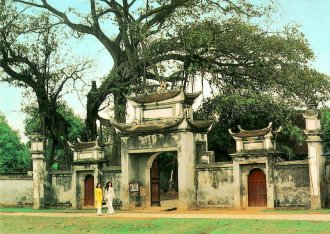 |
The Entrance of The Co Loa Citadel
( King An Duong Vuong - 25 centuries B.C.) |
|
- In 20000 BC, before the first history was recorded in writings, there had been already
among people the legends and mythology about the origin of mankind and stories
about the beginning of formation of Viet nation from HUNG VUONG.
These are stories on HONG BANG dynasty, on offspring of dragon and fairy, bag of hundred eggs,
eighteen kings of Hung Vuong dynasty, Son Tinh - Thuy Tinh's conflict, Thanh Giong's
victory over An foreign aggressors, folk of betel and areca nuts, "banh chung banh day",
watermelon... All these legends together can be regarded as a folk history comprising
mythology characteristic as well as core of history in memory and tradition through
many ages of people.
|
|
- In era of TRAN (1226-1400) and LE (1428-1527), these historic legends were firstly
collected and compiled by the contemporary authors' view. The two symbolic works of
this aspect were Viet Dien U Linh (The Stories from The Mysterious Temples of The Viets)
by Ly Te Xuyen with a foreword in 1329, and Linh Nam Trich Quai ( The Mystical Stories
from the Southern Land) by Tran The Phap in around end of Tran, then edited by Vu
Quynh and Kieu Phu in Le era with prologue in 1492-1493.
- Viet Su Luoc (A Brief History of Viet) is a work in Tran era mentioning about the formation
of Van Lang, for the first time. Ngo Si Lien especially brought Hung Vuong era into official
history of Viet Nam under the title of "Hong Bang Dynasty" in addenda chapter of his Dai Viet
Su Ky Toan Thu (The Complete History of The Great Viet).
- In 20th Century, in his Viet Nam Su Luoc (A Brief History of Viet Nam), Tran Trong Kim, has
reserved a chapter for "Hong Bang dynasty" however gave these remarks : "The historians
only collected the traditional legends, which were deity and fairy tales, non-natural", and "the story of Hong Bang dynasty was possibly not
true". Besides the works with traditional view, there were a number of studies of
European, especially French scholars. On the other hand, the legendary nature of the
document confused the historians at that time. Even Ngo Si Lien, who must both
agreed to the existence of the Hung Vuong era and also showed caution, when he
writes : "Let simply narrate the old story to transmit suspicions'.
- Events in Viet Nam Pre-Historic Era
10000-8000 B.C. : Mesolithic; Hoa Binh Culture
8000-6000 B.C.: Inferior Neolithic : Bao Son Cultur
6000-4000 B.C.: Middle Neolithic : Da But Cultur.
4000-3000 B.C.: Superior Neolithic .
2100- 1500 B.C.:Phung Nguyen Culture
750-300 ans B.C.: Dysnasty of the Hu`ng kings and beginning of the Dongsonian Culture
3rd century B.C.: Foundation of ¬u Lac kingdom
Year 207 B.C.: TriÍu Dŗ founded Nam Viet and established its capital at Phien Ngu (near Canton)
Year 196 B.C.: TriÍu Dŗ acknowledged vassalage towards China
One-Thousand-Year Chinese Domination
- In 221 BC the Ch'in dynasty in China completed its conquest of neighboring states and
became the first to rule over a united China. The Ch'in Empire, however, did not long
survive the death of its dynamic founder, Shih Huang Ti, and the impact of its collapse
was soon felt in Viet Nam. In the wreckage of the empire, the Chinese commander in
the south built his own kingdom of Nam Viet (South Viet; Chinese, Nan YŁeh); the young
state of Au Lac was included.
- In 111 BC, Chinese armies conquered Nam Viet and absorbed it into the growing Han
Empire. The Chinese conquest had fateful consequences for the future course of
Vietnamese history. After briefly ruling through local chieftains, Chinese rulers
attempted to integrate Viet Nam politically and culturally into the Han Empire. Chinese
administrators were imported to replace the local landed nobility. Political institutions
patterned after the Chinese model were imposed, and Confucianism became the
official ideology.
- The Chinese language was introduced as the medium of official and
literary expression, and Chinese ideographs were adopted as the written form for the
Vietnamese spoken language. Chinese art, architecture, and music exercised a
powerful impact on their Vietnamese counterparts. .

 |
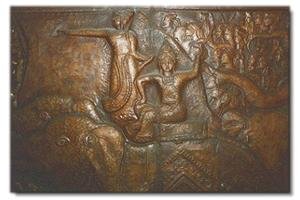 |
|
The Trung Sisters - Uprising Against The Chinese Domination |
|
- In Vietnamese resistance to rule by the Chinese was fierce but sporadic. The most
famous early revolt took place in AD 39, when two widows of local aristocrats, the Trung
sisters, led an uprising against foreign rule. The revolt was briefly successful, and the
older sister, Trung Trac, established herself as ruler of an independent state. Chinese
armies returned to the attack, however, and in AD 43 Viet Nam was reconquered.
- The Trung sisters' revolt was only the first in a series of intermittent uprisings that took
place during a thousand years of Chinese rule in Viet Nam. Finally, in 939, Vietnamese
forces under Ngo Quyen took advantage of chaotic conditions in China to defeat local
occupation troops and set up an independent state.
|
|
Independence and Chinese Influence

 |
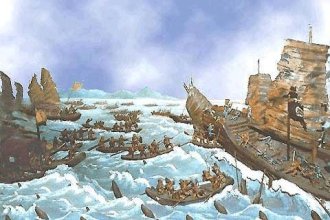
Ngo Quyen defeated the Chinese at Battle at Bach Dang River
Viet Nam Independence for the First Time
|
- Ngo Quyen's death a few years later ushered in a period of civil strife, but in the early 11th century the first of the great
Vietnamese dynasties was founded. Under the astute leadership of several dynamic
rulers, the Ly dynasty ruled Viet Nam for more than 200 years, from 1010 to 1225.
Although the rise of the Ly reflected the emergence of a lively sense of Vietnamese
nationhood, Ly rulers retained many of the political and social institutions that had been
introduced during the period of Chinese rule.
|
|
- Confucianism continued to provide the
foundation for the political institutions of the state. The Chinese civil service
examination system was retained as the means of selecting government officials, and
although at first only members of the nobility were permitted to compete in the
examinations, eventually the right was extended to include most males.
- The educational
system also continued to reflect the Chinese model. Young Vietnamese preparing for
the examinations were schooled in the Confucian classics and grew up conversant with
the great figures and ideas that had shaped Chinese history.
- Vietnamese society, however, was more than just a pale reflection of China. Beneath
the veneer of Chinese fashion and thought, popular mostly among the upper classes,
native forms of expression continued to flourish. Young Vietnamese learned to
appreciate the great heroes of the Vietnamese past, many of whom had built their
reputation on resistance to the Chinese conquest. At the village level, social mores
reflected native forms more than patterns imported from China. Although to the
superficial eye Viet Nam looked like a "smaller dragon," under the tutelage of the great
empire to the north it continued to have a separate culture with vibrant traditions of its
own.
- Fence off the North and March to the South
While the Vietnamese maintained their vigilance toward the north, an area of equal and
growing concern lay to the south. For centuries, the Vietnamese state had been
restricted to its heartland in the Red River valley and adjacent hills. Tension between
Viet Nam and the kingdom of Champa , a seafaring state
along the central coast, appeared shortly after the restoration of Vietnamese
independence. On several occasions, Cham armies broke through Vietnamese
defenses and occupied the capital near Hanoi. More frequently, Vietnamese troops
were victorious, and they gradually drove Champa to the south. Finally, in the 15th
century, Vietnamese forces captured the Cham capital south of present-day Da Nang
and virtually destroyed the kingdom.
For the next several generations, Viet Nam
continued its historic "march to the south," wiping up the remnants of the Cham
Kingdom and gradually approaching the marshy flatlands of the Mekong delta. There it
confronted a new foe, the Khmer Empire, which had once been the most powerful state
in the region. By the late 16th century, however, it had declined, and it offered little
resistance to Vietnamese encroachment. By the end of the 17th century, Viet Nam had
occupied the lower Mekong delta and began to advance to the west, threatening to
transform the disintegrating Khmer state into a mere protectorate.
- Ly Dynasty (1010 - 1225)
In 1010 the first Vietnamese Ly Dynasty emperor who is independent from China establishes
himself in Thang Long (present-day Hanoi). Before that, for more than 1,000 years, the
Vietnamese core land (the delta of the Red River, flowing into the Tonkin Bay of the South
China Sea) was either just a Chinese province or ruled by Vietnamese dynasties more or less
accepting Chinese overlordship.
- The Le Dynasty (1428-1789)
The Vietnamese advance to the south coincided with new challenges in the north. In
1407 Viet Nam was again conquered by Chinese troops. For two decades, the Ming
dynasty attempted to reintegrate Viet Nam into the empire, but in 1428, resistance
forces under the rebel leader Le Loi dealt the Chinese a decisive defeat and restored
Vietnamese independence. Le Loi mounted the throne as the first emperor of the Le
dynasty. The new ruling house retained its vigor for more than a hundred years, but in
the 16th century it began to decline.
- 150-Year North South Separation (The Trinh - Nguyen Conflict)
Although the country was still under the the nomial Le Dynasty. Power at court was wielded
by two rival aristocratic clans, the Trinh and the Nguyen. When the former became dominant, the Nguyen were
granted a fiefdom in the south, dividing Viet Nam into two separate zones. Rivalry was
sharpened by the machinations of European powers newly arrived in Southeast Asia in
pursuit of wealth and Christian converts.
By the late 18th century, the Le dynasty was near collapse. Vast rice lands were
controlled by grasping feudal lords. Angry peasantsóled by the Tay Son
brothersórevolted, and in 1789 Nguyen Hue, the ablest of the brothers, briefly restored
Viet Nam to united rule which ended the Le Dynasty. Nguyen Hue died shortly after ascending
the throne; a few years later Nguyen Anh, an heir to the Nguyen house in the south,
defeated the Tay Son armies.

 |
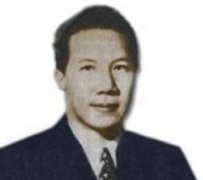
King Bao Dai - Last Emperor of the Nguyen Dynasty
|
- Nguyen Dynasty (1802-1945)
After unified Viet nam, Nguyen Anh became Emperor Gia Long, he established a new dynasty in 1802. The next Emperors
were Minh Mang, Thieu Tri and Tu Duc. Although the Nguyen Dynaty officially ended in 1945 with the
declaration of Last Emperor Bao Dai, The country was under the colonization of the South (CochinChina) and
under the protectorate of the North (Tonkin) and the Central (Annam).
|
|
- French Domination (1862-1954)
In 1859 French troops conquered Saigon. The French intervention was triggered by the
persecution of Christians in the Vietnamese empire, which started in the 30's of the
19th century. Between 1848 and 1860,
25 European priests, some 3,000 Vietnamese priests and more than 30,000 Vietnamese Catholics
are executed.
In 1862 the Vietnamese emperor Tu Duc surrenders South Vietnam to the
French, who set up their colony of Cochin China. Apart from that, Emperor Tu Duc has
to assure an end to the persecution of Christians.

 |
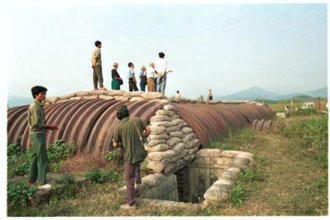
The Old Battleground Dien Bien Phu
|
In 1883 France forces the yet
uncolonialized part of Vietnam to accept the status of a French protectorate.
Administratively the French divide the country into the colony Cochin China (in the South)
and the protectorates Annam (central Vietnam) and Tonkin (North Vietnam).
In September 1940, after the conquest of France by German armies, Japanese troops occupy
Indochina without meeting any resistance. Officially the word is that the French colonial
power leaves all military installation for the Japanese to use; in response the French colonial
administration remains in office. Therefore the years of World War II mean less war
activity and destruction for Vietnam than, for instance, the fiercely contended Southeast
Asian states of Burma and the Philippines.
|
|
With the Japanese capitulation on August 14, 1945, World War II ends in East Asia.
France attempts to establish herself again as colonial power in Vietnam.
- North and South Viet Nam - The Viet Nam War (1954-1975)
In 1954 French troops were defeated at Dien Bien Phu, and The Geneva Accord divided Viet nam
in 2 parts with the separation line is 17th Parallel (Ben Hai): South Viet nam under the Western
influence, and North Viet Nam under the Communist rule.
In the South, Pesident Ngo Dinh Diem established a properous country from 1954-1963.
But in the fall of 1963, Diem was overthrown and killed in a coup. In the political
confusion that followed, the security situation in South Viet Nam continued to
deteriorate, putting the Communists within reach of victory. In early 1965, to prevent
the total collapse of the Saigon regime, U.S. President Lyndon Johnson approved
regular intensive bombing of North Viet Nam and the dispatch of U.S. combat troops into the South.
The U.S. intervention caused severe problems for the Communists on the battlefield
and compelled them to send regular units of the North Vietnamese army into the South.
It did not persuade them to abandon the struggle, however, and in 1968, after the
North's bloody Tet offensive shook the new Saigon regime of President Nguyen Van
Thieu to its foundations, the Johnson administration decided to pursue a negotiated
settlement. The new U.S. president, Richard Nixon, continued Johnson's policy
while gradually withdrawing U.S. troops. In January 1973 the war temporarily came to
an end with the signing of a peace agreement in Paris. In early 1975 the Communists
launched a military offensive. And on April 30. 1975 the Communists seized
power in Saigon.
- Socialist Republic of Viet Nam (1975 - Present)
In 1976 the South was reunited with the North in a new Socialist Republic of Viet Nam.
The conclusion of the war, however, did not end the violence. Border tension with the
Communist government in Cambodia escalated rapidly after the fall of Saigon, and in
early 1979 the Vietnamese invaded Cambodia and installed a pro-Vietnamese government.
A few weeks later, Viet Nam was itself attacked by its Communist neighbor, China.
In the mid-1980s, about 140,000 Vietnamese troops were stationed in Cambodia and another
50,000 troops in Laos. Viet Nam substantially reduced its forces in Laos during 1988
and withdrew virtually allits troops from Cambodia by September 1989.
Within Viet Nam, postwar economic and social problems were severe, and reconstruction
proceeded slowly. Efforts to collectivize agriculture and nationalize business aroused
hostility in the south. Disappointing harvests and the absorption of resources by the
military further retarded Viet Nam's recovery. In the early 1990s the government ended
price controls on most agricultural production, encouraged foreign investment, and sought
to improve its foreign relations.
In 1990 the European Community (now the European Union)
established official diplomatic relations with Viet Nam. The country signed a peace
agreement with Cambodia in 1991 and shortly thereafter restored diplomatic relations with
China. The peace agreement also forged the way for strengthening relations with the members
of the Association of Southeast Asian Nations (ASEAN). In 1992 Viet Nam signed a 1976 ASEAN
agreement on regional amity and cooperation, regarded as the first step toward eventual
ASEAN membership. Also in 1992, Viet Nam established diplomatic relations with South Korea.
The United States removed a trade embargo in 1994, and in 1995 Viet Nam and the United States
agreed to exchange low-level diplomats, and finally full diplomatic relations (which involve
opening embassies and appointing ambassadors) have been established. And last but not least
President Bill Clinton made his last historical presidential trip to Viet Nam before leaving
his office at the end of Year 2000.
|